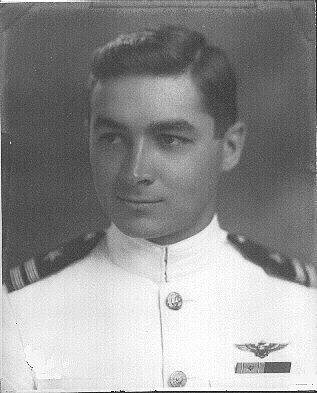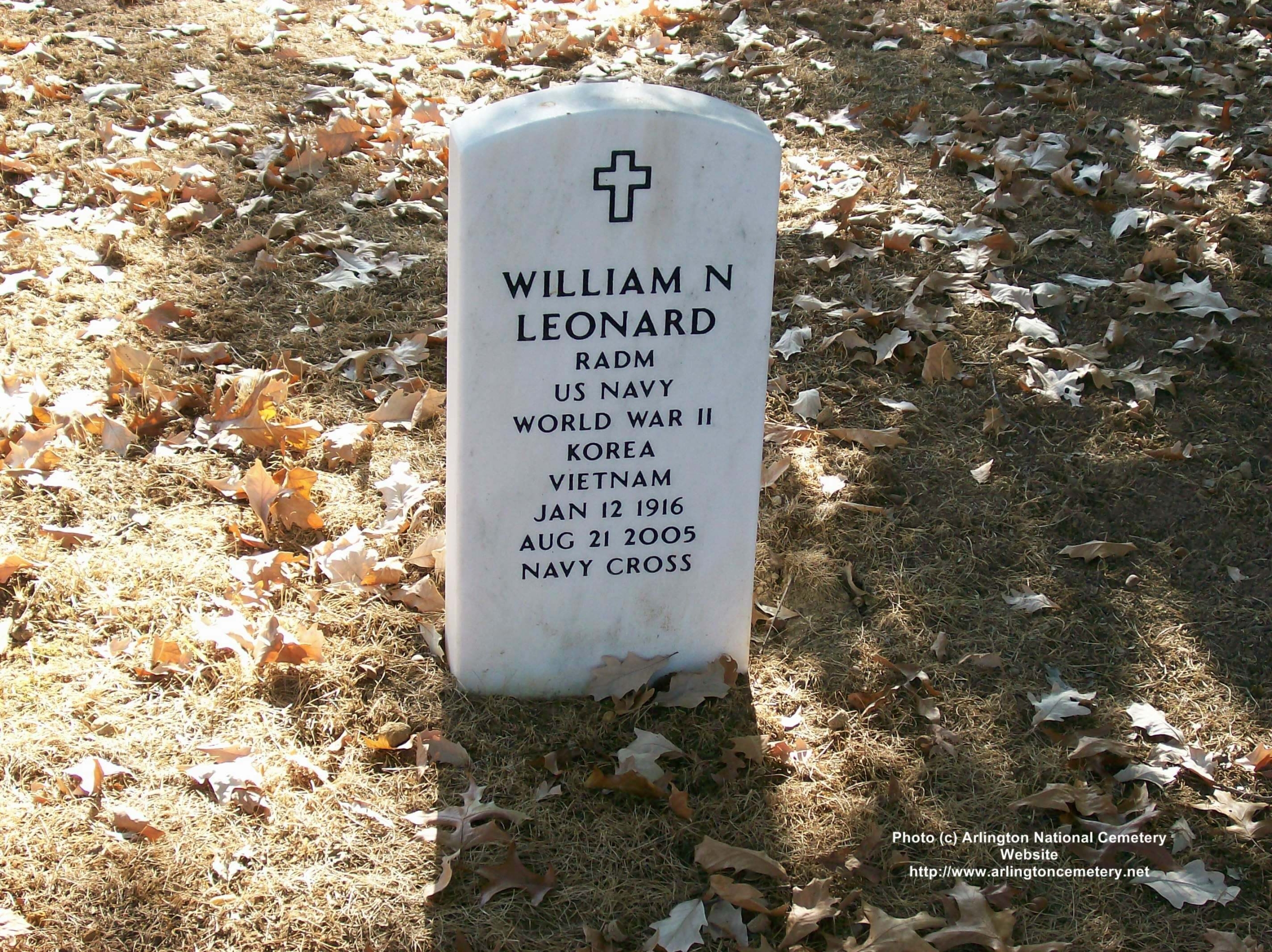Admiral Leonard, a graduate of the United States Naval Academy, took a prominent part in the Battle of Midway in World War II. He was received two (2) awards of the Navy Cross for his Naval service, as well as the Legion of Merit the Distinguished Flying Cross, the Air Medal (8 awards) and the Bronze Star Medal.
He is related to Charles Frederick Leonard, Colonel, United States Army, Charles Frederick Leonard, Jr., Major General, United States Army, John Wallis Leonard, Lieutenant Colonel, United States Army, who was killed in World War II, and Charles Frederick Leonard III, Captain, United States Army, who died in 1967.
WILLIAM N. LEONARD, REAR ADMIRAL, USN
William N. Leonard, Rear Admiral USN (Retired), died on August 21, 2005, following a brief illness. Admiral Leonard was born in Douglas, Arizona on January 12, 1916, and graduated in 1938 from the U.S. Naval Academy, where he was on the varsity swimming team. He is buried with his beloved wife of 55 years, Mary Louise, who preceded him in death. Other family members buried in nearby gravesites include his father, US Army Colonel Charles F. Leonard; mother, Hannah M. Leonard; and two brothers, Charles F. Jr., West Point ’35, and John Wallis, West Point ’42. Charles was the silver medalist in pentathlon in the 1936 Berlin Olympics and had a distinguished Army career, attaining the rank of Major General. Wallis, a Lieutenant Colonel in the Army Air Forces, was killed in action during World War II. Admiral Leonard was survived by five children, eight grandchildren, one great-grandchild, and many nieces and nephews.
Designated Naval Aviator #6953 in 1940, Bill Leonard was a fighter pilot who became an ace early in World War II during the battles of Coral Sea and Midway and on Guadalcanal in the Solomon Islands campaign. Later in the war, while attached to the staff of Commander Fleet Air, West Coast, he flew the first captured Japanese A6M2-21 Zero fighter and the experimental Ryan XFR-1 Fireball fighter, playing a key role in the training of new fighter pilots and the advancement of Navy fighter doctrine and tactics. Returning to combat operations, he was on the staff of Task Force 38, Admiral John S. McCain, during the final drive to victory in the Pacific. In all, he flew some 170 combat missions during World War II.
Bill was a leader in Naval Aviation throughout his career. In his initial post-war assignment, he was a member of the first test pilot class, TPT-1, at the Naval Air Test Center at Patuxent Naval Air Station, where he flew more than 20 different types of aircraft. He qualified as a jet pilot early in 1946, and was appointed commanding officer of VF-17A (subsequently designated VF-171), the first jet squadron to qualify for carrier operations. While serving as CO of VF-171, he was called upon to present testimony concerning the capabilities of high performance jet aircraft during the House Armed Services Committee hearings that probed the B-36 controversy in October 1949. He later directed the team that developed the requirements for the Navy’s renowned all-weather carrier-based attack aircraft, the A-6 Intruder. His other operational commands included: Air Group 17, Air Development Squadron FivE (VX-5), USS SALAMONIE (AO-26), USS RANGER (CV-61), Carrier Division 14, and the Naval Safety Center.
Over the course of his 33 year career, he logged more than 4,000 flight hours in some 80 different aircraft types or major model variants, ranging from the N3N biplane in 1940 to the F-4 Phantom II in 1961. He made 330 carrier landings.
In addition to two Navy Crosses won at Coral Sea and Midway, his awards included: four Legions of Merit, one with Combat ‘V’; the Distinguished Flying Cross; the Bronze Star with Combat ‘V’; six Air Medals; and numerous other commendations and service ribbons.
Retiring in 1971 to Virginia Beach, Virginia, Bill and Mary Lou enjoyed 25 years of quiet happiness together and in the company of their loving family, until her untimely death in 1996. In retirement, Bill avidly pursued a wide range of interests, including timepieces, woodworking, gardening, and the study of history. He was frequently sought out by historians of Naval Aviation and World War II carrier operations, and responded generously to their needs, tirelessly reviewing and commenting on manuscripts and providing source material, insights, and contacts for further research.
Interment with full honors was at Arlington National Cemetery on November 16, 2005.
Courtesy of and with the permission of the Richmond Times-Dispatch:
Originally Published: 27 August 2005
Rear Admiral William N. Leonard, United States Navy (retired) passed away on Sunday, August 21, 2005, after a brief illness.
Admiral Leonard was born on January 12, 1916, in Douglas, Arizona, and was a 1938 graduate of the U.S. Naval Academy. He was the son of the late Colonel Charles F. and Mrs. Hannah L. Leonard. He was preceded in death by his beloved wife of 55 years, the former Mary Louise Butt, of Norfolk, Virginia. He is survived by his children, William N. Leonard Jr. and his wife, Victoria, of Midland, Virginia, John W. Leonard of Herndon, Virginia, Elizabeth L. Sufit and her husband, Dr. Carl R. Sufit, of Escalon, California, Richard A. Leonard and his wife, Desiree of Chester, Virginia, and Miss Mary Louise Leonard also of Chester; his brother, Major General Charles F. Leonard Jr., United States Army (retired) of Fairfax, Virginia; his sister-in-law, Miss Virginia Butt of Chester; eight grandchildren, Kathryn Leonard, Colleen Leonard, Elise Dawson, Kaitlin Sufit, Carolyn Sufit, Megan Leonard, Sarah Leonard, and John W. Leonard Jr.; one great-grandchild, Alison Dawson; and numerous nieces and nephews.
Admiral Leonard was designated Naval Aviator # 6953 in December 1940. A World War II fighter pilot, he was an early leader and an ace in the Pacific battles of the Coral Sea, Midway and in the Solomons. He played a key role in the wartime development of Navy fighter tactics and was a pioneer in using captured enemy aircraft for training purposes. At war’s end, he was an operations officer with Commander Task Force 38 in the drive to victory in the Pacific. After the war, he continued as a leader in Naval Aviation, commanding VF-171, the first Navy jet squadron to operate from an aircraft carrier.
A founding test pilot at the Naval Air Test Center, Patuxent River, he later directed the team that developed the requirements for the A-6 Intruder. Other commands included Commander, Air Group 17; Commander, VX-5; Captain, USS Salamonie; Captain, USS Ranger; Commander, Carrier Division 14, bringing his flag aboard USS Wasp; and Commander, Naval Safety Center. His promotion to Rear Admiral came in 1965.
By the end of his career, he had operated from 18 different aircraft carriers. Admiral Leonard was awarded two Navy Crosses for Valor at the battles of the Coral Sea and Midway. His other awards included four Legions of Merit, one with Combat ‘V’, the Distinguished Flying Cross, the Bronze Star with Combat ‘V’; six Air Medals, and other commendation and service ribbons.
Retiring to Virginia Beach, Virginia, in 1971, Admiral Leonard and his wife, Mary Lou, enjoyed 25 years of quiet happiness together and in the company of their loving family, until her untimely death in 1996. In retirement, he avidly pursued a wide range of interests, including timepieces, woodworking, and gardening. He frequently was sought out by historians of Naval Aviation and World War II carrier operations, and responded generously to their needs, tirelessly reviewing and commenting on manuscripts and providing source material, insights, and contacts for further research. He moved to his son’s home in Chester in 2001.
Interment will be at Arlington National Cemetery, with full honors, on November 16, 2005. In lieu of flowers, it is requested that memorial donations be made to the Naval Aviation Museum Foundation, 1750 Radford Blvd, Suite B, Naval Air Station, Pensacola, Florida 32501.
LEONARD, WILLIAM NICHOLAS
(First Award)
Citation:
The President of the United States takes pleasure in presenting the Navy Cross to William Nicholas Leonard, Lieutenant, Junior Grade, U.S. Navy, for extraordinary heroism and distinguished service in the line of his profession while serving as Pilot of a carrier-based Navy Fighter Plane of Fighting Squadron FORTY-TWO (VF-42), embarked from the U.S.S. YORKTOWN (CV-5), in action against the Japanese on 4 and 8 May 1942.
On 4 May, while leader of a four-plane division engaged in protecting our own forces attacking Tulagi Harbor, he led his division in four successive strafing attacks against an enemy destroyer and, in the face of heavy anti-aircraft fire, succeeded in inflicting serious damage on the enemy vessel. On the same occasion he led his section in a determined attack against three enemy seaplane fighters, destroying two of them and assisting in the destruction of the third.
On 8 May, while leader of the fighter escort for our own torpedo planes in an attack against an enemy carrier in the Coral Sea, he aggressively engaged the enemy fighter opposition, skillfully assisting in the destruction of two of the enemy planes. None of our torpedo planes were damaged during this attack which resulted in the sinking or severe damaging of the carrier. While returning from this mission he encountered an enemy torpedo plane returning to its carrier. He led his section in an attack against this plane and assisted in the prompt destruction of the enemy aircraft.
Throughout these engagements Lieutenant, Junior Grade, Leonard displayed outstanding leadership, aggressiveness and judgment. His conduct was always unusually courageous and with complete disregard for his own personal safety, and were in keeping with the highest traditions of the Naval Service.
LEONARD, WILLIAM NICHOLAS
(Second Award)
Citation:
The President of the United States takes pleasure in presenting a Gold Star in lieu of a Second Award of the Navy Cross to William Nicholas Leonard, Lieutenant, Junior Grade, U.S. Navy, for extraordinary heroism and distinguished service in the line of his profession while piloting an airplane of Fighting Squadron THREE (VF-3), embarked from the U.S.S. YORKTOWN (CV-5), in action against enemy Japanese forces on 4 June 1942, during the “Air Battle of Midway.”
Lieutenant, Junior Grade, Leonard was launched from his carrier to intercept an incoming attack by Japanese torpedo planes. He had been in the air only a few seconds when the enemy planes started their runs prior to dropping their torpedoes. With great skill, courage and determination, and despite the heavy anti-aircraft fire from his own ships, he pressed home repeated attacks against the enemy planes shooting down one and damaging another.
His courage, determination and utter disregard for personal safety were in keeping with the highest traditions of the Naval Service.
LEONARD, WILLIAM N
RADM US NAVY
WORLD WAR II, KOREA, VIETNAM
- DATE OF BIRTH: 01/12/1916
- DATE OF DEATH: 08/21/2005
- BURIED AT: SECTION 1 SITE 304-C-1
ARLINGTON NATIONAL CEMETERY
LEONARD, MARY LOUISE
- DATE OF BIRTH: 03/04/1920
- DATE OF DEATH: 12/03/1996
- BURIED AT: SECTION 1 SITE 304-C-1
ARLINGTON NATIONAL CEMETERY - WIFE OF LEONARD, WILLIAM N, RADM US NAVY
Michael Robert Patterson was born in Arlington and is the son of a former officer of the US Army. So it was no wonder that sooner or later his interests drew him to American history and especially to American military history. Many of his articles can be found on renowned portals like the New York Times, Washingtonpost or Wikipedia.
Reviewed by: Michael Howard


